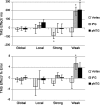The neural organization of semantic control: TMS evidence for a distributed network in left inferior frontal and posterior middle temporal gyrus
- PMID: 20851853
- PMCID: PMC3077429
- DOI: 10.1093/cercor/bhq180
The neural organization of semantic control: TMS evidence for a distributed network in left inferior frontal and posterior middle temporal gyrus
Abstract
Assigning meaning to words, sounds, and objects requires stored conceptual knowledge plus executive mechanisms that shape semantic retrieval according to the task or context. Despite the essential role of control in semantic cognition, its neural basis remains unclear. Neuroimaging and patient research has emphasized the importance of left inferior frontal gyrus (IFG)--however, impaired semantic control can also follow left temporoparietal lesions, suggesting that this function may be underpinned by a large-scale cortical network. We used repetitive transcranial magnetic stimulation in healthy volunteers to disrupt processing within 2 potential sites in this network--IFG and posterior middle temporal cortex. Stimulation of both sites selectively disrupted executively demanding semantic judgments: semantic decisions based on strong automatic associations were unaffected. Performance was also unchanged in nonsemantic tasks--irrespective of their executive demands--and following stimulation of a control site. These results reveal that an extended network of prefrontal and posterior temporal regions underpins semantic control.
Figures





Similar articles
-
Executive semantic processing is underpinned by a large-scale neural network: revealing the contribution of left prefrontal, posterior temporal, and parietal cortex to controlled retrieval and selection using TMS.J Cogn Neurosci. 2012 Jan;24(1):133-47. doi: 10.1162/jocn_a_00123. Epub 2011 Aug 23. J Cogn Neurosci. 2012. PMID: 21861680 Free PMC article.
-
Automatic and Controlled Semantic Retrieval: TMS Reveals Distinct Contributions of Posterior Middle Temporal Gyrus and Angular Gyrus.J Neurosci. 2015 Nov 18;35(46):15230-9. doi: 10.1523/JNEUROSCI.4705-14.2015. J Neurosci. 2015. PMID: 26586812 Free PMC article.
-
Exploring the role of the posterior middle temporal gyrus in semantic cognition: Integration of anterior temporal lobe with executive processes.Neuroimage. 2016 Aug 15;137:165-177. doi: 10.1016/j.neuroimage.2016.05.051. Epub 2016 May 25. Neuroimage. 2016. PMID: 27236083 Free PMC article.
-
The neural basis of semantic cognition: converging evidence from neuropsychology, neuroimaging and TMS.Cortex. 2013 Mar;49(3):611-25. doi: 10.1016/j.cortex.2012.10.008. Epub 2012 Nov 13. Cortex. 2013. PMID: 23260615 Review.
-
Functional MRI of language: new approaches to understanding the cortical organization of semantic processing.Annu Rev Neurosci. 2002;25:151-88. doi: 10.1146/annurev.neuro.25.112701.142946. Epub 2002 Mar 19. Annu Rev Neurosci. 2002. PMID: 12052907 Review.
Cited by
-
The effect of object state-changes on event processing: do objects compete with themselves?J Neurosci. 2012 Apr 25;32(17):5795-803. doi: 10.1523/JNEUROSCI.6294-11.2012. J Neurosci. 2012. PMID: 22539841 Free PMC article.
-
Differential contributions of inferior frontal gyrus subregions to sentence processing guided by intonation.Hum Brain Mapp. 2023 Feb 1;44(2):585-598. doi: 10.1002/hbm.26086. Epub 2022 Oct 3. Hum Brain Mapp. 2023. PMID: 36189774 Free PMC article.
-
Identifying brain systems for gaze orienting during reading: fMRI investigation of the Landolt paradigm.Front Hum Neurosci. 2013 Jul 29;7:384. doi: 10.3389/fnhum.2013.00384. eCollection 2013. Front Hum Neurosci. 2013. PMID: 23908615 Free PMC article.
-
The Metacognitive and Neurocognitive Signatures of Test Methods in Academic Listening.Front Psychol. 2022 Jun 10;13:930075. doi: 10.3389/fpsyg.2022.930075. eCollection 2022. Front Psychol. 2022. PMID: 35783744 Free PMC article.
-
TMS Reveals Dynamic Interaction between Inferior Frontal Gyrus and Posterior Middle Temporal Gyrus in Gesture-Speech Semantic Integration.J Neurosci. 2021 Dec 15;41(50):10356-10364. doi: 10.1523/JNEUROSCI.1355-21.2021. Epub 2021 Nov 16. J Neurosci. 2021. PMID: 34785579 Free PMC article.
References
-
- Badre D. Cognitive control, hierarchy, and the rostro-caudal organization of the frontal lobes. Trends Cogn Sci. 2008;12:193–200. - PubMed
-
- Badre D, D'Esposito M. Functional magnetic resonance imaging evidence for a hierarchical organization of the prefrontal cortex. J Cogn Neurosci. 2007;19:2082–2099. - PubMed
-
- Badre D, Poldrack RA, Pare-Blagoev EJ, Insler RZ, Wagner AD. Dissociable controlled retrieval and generalized selection mechanisms in ventrolateral prefrontal cortex. Neuron. 2005;47:907–918. - PubMed
-
- Badre D, Wagner AD. Left ventrolateral prefrontal cortex and the cognitive control of memory. Neuropsychologia. 2007;45:2883–2901. - PubMed

